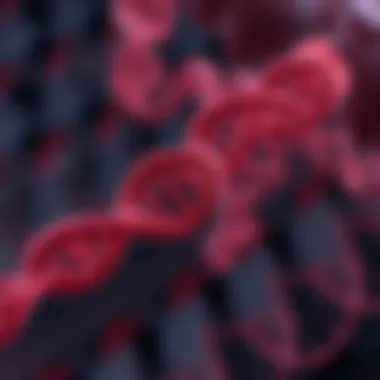Understanding the MyBPC3 Gene and Its Cardiac Role


Intro
The MyBPC3 gene is a cornerstone in the realm of cardiac genetics, specifically linked to heart health and muscle structure. Nestled on chromosome 11, this gene encodes the cardiac muscle protein known as myosin-binding protein C. While many may not be familiar with the MyBPC3 gene on a personal level, its implications on heart function and various cardiac ailments are profound. Understanding its role is not just an academic venture; it bears significant relevance to those grappling with heart disease and related disorders, making the exploration of its intricacies both timely and essential.
As we delve into this topic, we will uncover the essential biological functions of the MyBPC3 gene, its evolutionary significance, and how its mutations could potentially predispose individuals to conditions like hypertrophic cardiomyopathy. The discussion will address recent advancements in research and therapeutic strategies, reflecting how such insights craft a new narrative in the battle against heart disease. In this article, researchers and enthusiasts alike will find a thorough examination of a gene that plays an outsized role in our understanding of cardiac function.
Prelude to the MyBPC3 Gene
The MyBPC3 gene occupies a significant niche in cardiac genetics, making it paramount to understand its intricacies and implications. This gene encodes the cardiac muscle protein myosin-binding protein C, essential for proper muscle contraction and overall heart function. As heart disease remains a leading cause of morbidity and mortality globally, unraveling the dimensions of MyBPC3 can potentially enhance our grasp of various cardiovascular diseases.
Definition and Discovery
The MyBPC3 gene, located on chromosome 11, was first characterized in the early 1990s. It codes for a protein integral to myocardial structure and function, directly involved in the regulation of cardiac muscle contraction. Understanding its journey from discovery is pivotal, as it sheds light on the evolving comprehension of cardiac function and genetics. Early research demonstrated that alterations in this gene could lead to aberrant protein production, resulting in cardiac dysfunction.
What makes the discovery savory is not just the identification of the gene but the implications of its mutations. These mutations have been shown to correlate with various cardiomyopathies, particularly hypertrophic cardiomyopathy, which can lead to unforeseen cardiac events in seemingly healthy individuals. This revelation was like a light bulb moment in cardiology, emphasizing the importance of genetic research in the realm of cardiovascular health.
Physical Location and Structure
The MyBPC3 gene is nestled in a specific locus on chromosome 11, specifically at 11p15.5. This region has been the topic of extensive research due to its relationship with cardiac function. The structure of the MyBPC3 gene itself includes multiple exons and introns, key players in the splicing process that forms the mature mRNA transcript.
The protein encoded by MyBPC3 exhibits modular domains, which have specific functions tethered to the assembly and stability of the sarcomeres in cardiac muscle cells. Some notable features of MyBPC3 include:
- Presence of immunoglobulin-like domains: These are crucial for the protein's interaction with myosin and actin, the core proteins facilitating muscle contraction.
- Repetitive structural elements: These contribute to the resilience and elasticity of heart tissue, essential for maintaining efficient contractions.
Understanding the physical location and structure of MyBPC3 not only provides foundation knowledge for researchers but also emphasizes the importance of genetic mapping in elucidating the relationships between structure and function in cardiac physiology.
Biological Role of MyBPC3
The MyBPC3 gene holds a crucial position in our understanding of cardiac function. It's not merely a piece of genetic material; it's a cornerstone for cardiac muscle integrity. Beyond encoding the myosin-binding protein C, it provides insight into how muscles contract and maintain their form. A deep dive into MyBPC3 reveals how intimately it is tied to heart health and why understanding its biological role is paramount.
Function in Cardiac Muscle
At the heart of it all—no pun intended—MyBPC3 plays a pivotal function in cardiac muscle contraction and relaxation. This gene produces myosin-binding protein C, which interacts with myosin and actin filaments within the sarcomeres of heart muscle cells. Its role is akin to that of a conductor leading an orchestra, ensuring that muscles contract in harmony. Without adequate levels of myosin-binding protein C, heart muscles may struggle to contract properly, leading to dynamic and potentially life-altering repercussions.
The significance of MyBPC3 in cardiac muscle function can be highlighted through its involvement in several processes:
- Regulating Contraction: MyBPC3 is essential for fine-tuning the interaction between myosin and actin, ultimately influencing the strength of heartbeat. It ensures that contractions are neither too strong nor too weak, maintaining the heart’s rhythm and efficiency.
- Elasticity and Support: This protein aids in maintaining the structure and elasticity of the cardiac sarcomere. It acts as a scaffold, contributing to the physical integrity of cardiac muscle tissue.
- Response to Stress: MyBPC3 also plays a role in the heart's response to various stresses, including hypertrophy induced by increased workload. Through its actions, it helps the heart adapt and function effectively under duress.
In essence, without MyBPC3, the very fabric of cardiac muscular function would be at risk, leading to a cascade of potential health issues. Understanding this role not only helps clarify cardiac physiology but also strengthens our grasp on potential treatments and interventions for heart diseases.
Interactions with Other Proteins
The complexity of MyBPC3’s role extends far beyond its standalone functions; it also thrives through an extensive network of protein interactions. These connections paint a broader picture of how the cardiac muscle operates as a cohesive unit.
- Collaborating with Myosin: MyBPC3’s primary interaction is with myosin, the motor protein responsible for muscle contraction. This interaction is essential for proper sarcomere function, making MyBPC3 a vital component in maintaining the heart's energy-efficient function.
- Linking to Sarcomere Proteins: Beyond myosin, MyBPC3 interacts with other critical proteins, such as titin and actin. These interactions bolster the mechanical properties of heart muscles and contribute to their overall functionality. It's a complex dance, where each protein must perform its role effectively to maintain overall heart health.
- ** involvement in Signaling Pathways**: MyBPC3 also plays a role in signaling pathways that mediate cellular responses to hormones and other stimuli. This connection between contractile function and cellular signaling is particularly useful in understanding various forms of cardiomyopathy and how alterations in these pathways can lead to disease.
In summary, the interactions surrounding MyBPC3 underscore its importance far beyond the realm of mere structural support. By engaging with a host of other proteins, it helps create a robust network that is essential for optimal heart function. The implications of these interactions offer a wealth of insight into potential therapeutic avenues and research opportunities in the field of cardiac genetics.
Understanding MyBPC3's role interwoven with other proteins provides critical insights into cardiac health and disease—knowledge that is vital as we further delve into genetic studies and innovative treatments.
Genetic Variations and Mutations
The realm of genetics often provides insight into the delicate dance of life at a molecular level. When it comes to the MyBPC3 gene, understanding its variations and mutations becomes pivotal, especially in the context of cardiac health. Mutations in genes can be viewed as tiny but powerful disruptions, akin to a well-placed pebble in a shoe that may seem insignificant but causes discomfort when walked upon for any length of time. In the case of MyBPC3, these disruptions can lead to various cardiac conditions, marking the need for a deeper understanding of both common and rare mutations.
Common Mutations in MyBPC3
MyBPC3 isn't just a random collection of genetic code; it's a crucial player in the structure of cardiac muscle. Common mutations in this gene often include missense mutations, where a single nucleotide change results in a different amino acid in the resultant protein. Some frequently encountered mutations involve changes such as Arg92Gly and Glu143Lys. These mutations can disrupt the protein's function, impacting its ability to bind properly to myosin or to maintain structural integrity within cardiac muscle fibers.
Understanding these common mutations is essential, not merely for researchers, but also for clinicians who can better assess risks and causes of cardiac abnormalities in patients.
Important common mutations in MyBPC3 include:
- Arg92Gly: Affects cardiac contractility.
- Glu143Lys: Known to be linked to hypertrophic cardiomyopathy.
Tracking variations like these can aid geneticists in developing targeted screening programs, which can potentially save lives by aiding early detection.


Impact of Mutations on Function
The impact of mutations on the functioning of the MyBPC3 gene is profound and multi-faceted, like ripples spreading in water after a stone is tossed. Simply put, alterations in the gene's structure can significantly impair the function of the myosin-binding protein, leading to a cascade of issues in muscle contraction and relaxation. Such mutations may not just disrupt the gene's protein product; they can also influence how cardiac muscle cells communicate with one another, affecting overall heart function.
Research indicates that individuals with mutations in MyBPC3 often present with two primary types of cardiomyopathies: hypertrophic and dilated. In hypertrophic cardiomyopathy, the heart muscle becomes abnormally thick, which can hinder blood flow and eventually lead to serious complications. Conversely, in dilated cardiomyopathy, the heart becomes weakened and enlarged, making it less effective in pumping blood.
"A mutation in MyBPC3 can be the tipping point in a series of cardiac events that lead to severe health implications, emphasizing the gene’s role not just as a component of heart structure but also as a critical factor for heart health."
The clinical significance of understanding these mutations extends beyond mere detection; it lays the groundwork for personalized medicine approaches where treatments can be tailored based on an individual’s specific genetic makeup—providing a nuanced and effective way to combat genetic heart diseases.
MyBPC3 and Cardiomyopathies
Understanding the relationship between the MyBPC3 gene and cardiomyopathies is essential for grasping how genetic factors contribute to heart disease. Cardiomyopathies, which encompass a variety of conditions affecting the heart muscle, can stem from genetic variations in numerous genes, including MyBPC3. This intricate link not only informs the clinical practice of cardiology but also enhances our overall comprehension of heart function and disease mechanisms. Moreover, this relationship underscores the importance of genetic screening as a preventive measure and as a crucial factor in the management of heart conditions.
Hypertrophic Cardiomyopathy
Hypertrophic cardiomyopathy, or HCM for short, is one of the most common genetic heart disorders. It is characterized by an abnormal thickening of the heart muscle, often leading to obstruction of blood flow. Variations in the MyBPC3 gene are frequently implicated in familial cases of HCM, as mutations can alter the structure and function of the myosin-binding protein C, which is integral to muscle contraction.
A notable aspect of HCM caused by MyBPC3 mutations is the variability of its expression. Not every individual carrying a mutation exhibits severe symptoms; some might lead a normal life. This phenomenon, called incomplete penetrance, reveals the complexity of genetic expressions and implications in understanding patients’ conditions. Therefore, genetic counseling becomes vital for families affected by HCM, to navigate risks and inform management plans.
"Understanding the role of MyBPC3 in HCM is not just about genetic testing; it's about recognizing heart health in a familial context."
Patients with HCM can present a range of symptoms that include shortness of breath, chest pain, and even syncope during exercise. A study from the Journal of the American College of Cardiology highlights how patients with mutations in MyBPC3 often experience more severe outcomes compared to those with mutations in other genes associated with HCM. Overall, understanding MyBPC3's role in HCM illuminates the delicate interplay between genetics and cardiac function.
Dilated Cardiomyopathy
On the other hand, dilated cardiomyopathy (DCM) represents another dimension in the clinical outcomes linked to the MyBPC3 gene. Unlike HCM, where the heart muscle thickens, DCM showcases a dilatation of the heart chambers, leading to weakened contractions and reduced cardiac output. Although multiple genes have been linked to DCM, MyBPC3 mutations are part of this intricate puzzle, though they are less common in DCM compared to HCM.
The MyBPC3 gene’s involvement in DCM can manifest in a variety of ways, including ventricular enlargement and decreased wall motion. These alterations often result in symptoms like fatigue and fluid retention. The interaction of MyBPC3 mutations with other risk factors, like high blood pressure or coronary artery disease, can exacerbate the progression of heart failure. Moreover, recent research indicates that individuals with DCM associated with MyBPC3 mutations may have a distinct clinical profile when it comes to treatment response compared to idiopathic cases.
Consequently, understanding the genetic basis of DCM not only emphasizes the role of MyBPC3 but also urges clinicians to tailor intervention strategies accordingly. Regular monitoring and early intervention can pave the way for more favorable outcomes in patients predisposed to DCM due to genetic factors.
In summary, the relationship between MyBPC3 and both hypertrophic and dilated cardiomyopathy illustrates the gene's significant impact on cardiac pathology. By delving into these connections, we can better understand the implications of genetic mutations for diagnosis, treatment, and counseling for affected individuals.
Diagnostic Approaches
The MyBPC3 gene, significant for its role in cardiac health, leads to an increasing necessity for distinct diagnostic methods. These approaches provide insights into genetic predispositions to heart diseases like cardiomyopathies, aiding in early detection and management.
Genetic Testing and Screening
Genetic testing for the MyBPC3 gene is crucial for both at-risk individuals and those already exhibiting symptoms of heart conditions. With various techniques such as sequencing and mutation analysis, healthcare providers can pinpoint alterations that could lead to hypertrophic or dilated cardiomyopathy. In families with a history of these conditions, regular genetic screening can illuminate whether someone carries a mutation, thus allowing for proactive measures to minimize risks.
- Techniques used in testing:
- DNA Sequencing: This is the gold standard that thoroughly examines the gene for mutations or changes. It identifies specific areas where alterations might affect protein function.
- Deletion and Duplication Testing: These tests can uncover larger alterations in the gene, which may not be detectable through standard sequencing techniques.
The results from these tests not only guide clinical decisions but also offer invaluable information for family planning, enabling individuals to make informed choices about their health and the health of their offspring. Genetic counseling often accompanies these tests, helping patients understand the implications of their results.
Biomarker Identification
The search for biomarkers related to MyBPC3 is another frontier where research is making strides. Biomarkers are biological indicators that can signal the presence or progression of a disease. In the context of MyBPC3 and cardiac health, specific proteins produced as a response to stress in cardiac muscle could be evaluated to indicate potential issues.
Key Points about Biomarkers:
- Types of Biomarkers: These could include proteins that can be found in the blood or tissue samples, reflecting ongoing cardiac stress or damage.
- Usage in Diagnostics: Biomarkers can serve as early warning signs, allowing for timely intervention even before physical symptoms manifest.
Researchers have been examining correlations between the levels of these biomarkers and the severity of cardiac conditions, aiming to create a robust framework for predicting disease progression. This endeavor could revolutionize the monitoring of cardiac health, leading to better patient outcomes.
Currently, the identification and validation of biomarkers related to MyBPC3 continue to play a fundamental role in enhancing diagnostic accuracy and informing treatment strategies.
In summary, robust diagnostic approaches, which include careful genetic testing and the identification of effective biomarkers, are essential for understanding and managing conditions related to the MyBPC3 gene. They not only highlight the importance of personalized medicine but also pave the path for advancements in therapeutic strategies.
Therapeutic Implications


The implications surrounding the MyBPC3 gene are of paramount importance in the realm of cardiology. Understanding this gene not only unfolds the mechanisms behind cardiac diseases but also lays the groundwork for innovative treatments. As research continues to delve into MyBPC3, the therapeutic implications become clearer. We can look at specific treatment avenues, emerging strategies, and the potential this gene holds in revolutionizing cardiac care.
Current Treatment Strategies
(Current treatment strategies) aimed at conditions linked to the MyBPC3 gene have shown progress. These treatments largely revolve around symptomatic relief and management of heart diseases, particularly hypertrophic cardiomyopathy and dilated cardiomyopathy.
- Pharmacological Interventions: Current medications include beta-blockers, calcium channel blockers, and anticoagulants, which are used to manage symptoms associated with cardiac hypertrophy and heart failure. These drugs work by regulating heart rhythms and reducing the workload on the heart.
- Lifestyle Modifications: For many patients, adopting healthier lifestyles plays a crucial role. Diet, exercise, and regular monitoring of vitals can substantially improve quality of life and prognosis.
- Devices and Surgery: In severe cases, devices like implantable cardioverter-defibrillators (ICDs) may be employed. Additionally, surgical interventions like septal myectomy might be necessary for alleviating obstruction caused by hypertrophic cardiomyopathy.
Each of these strategies represents a vital piece of the puzzle when it comes to managing the implications of MyBPC3 mutations. While they provide necessary relief, there’s an ever-growing need for more direct interventions targeting the underlying genetic issues.
Gene Therapy Approaches
Gene therapy presents exciting prospects for those with conditions linked to MyBPC3 mutations. This emerging field seeks to directly address the root cause by modifying or replacing the faulty genes.
- CRISPR-Cas9 Technology: One of the most revolutionary advancements in gene therapy is the CRISPR-Cas9 system. This technology allows for precise editing of genetic sequences, offering a potential pathway to repair the MyBPC3 gene itself. For example, if a particular mutation results in a non-functional protein, researchers can potentially correct that mutation to restore function.
- Adenoviral Vectors: While still in experimental stages, using viral vectors to deliver functional copies of the MyBPC3 gene might enable the correction of underlying defects. This approach has shown promise in preclinical models, allowing for the effective expression of functional myosin-binding protein C in cardiac muscle.
- RNA-Based Therapies: These therapies aim to interfere with the pathogenic expression of mutant alleles. Techniques such as antisense oligonucleotides (ASOs) could help modulate the splicing of MyBPC3 mRNA, ultimately reducing the impact of mutations.
Gene therapy is not without its challenges, though. Safety concerns and long-term efficacy are still under scrutiny. Nonetheless, the strides in this domain hold great potential that could redefine how we treat cardiac ailments originating from MyBPC3 anomalies.
"As we stand on the brink of gene therapy breakthroughs, the MyBPC3 gene emerges as a focal point for targeted cardiac interventions."
Ultimately, the therapeutic implications of the MyBPC3 gene are expansive. By embracing both current strategies and future innovations, there’s a real chance to enhance patient outcomes and perhaps change the landscape of cardiac care for the better. The blend of traditional and cutting-edge approaches could pave the way for a future where genetic heart diseases can be effectively managed, if not cured.
Recent Research Developments
Recent advancements in the understanding of the MyBPC3 gene have brought about significant enhancements in both the scientific and medical communities. The implications of these findings extend beyond the confines of basic science, influencing therapeutic strategies and offering new avenues for patient care. As researchers delve deeper into the genetic intricacies of MyBPC3, they uncover potential risk factors and connections to various cardiac conditions, positioning this gene at the forefront of cardiology.
New Findings in Genetics
The ongoing studies have illuminated several pathophysiological mechanisms associated with the MyBPC3 gene, revealing unexpected genetic variations. One landmark finding involves the identification of novel mutations that disrupt the normal function of the cardiac muscle protein. Previous research focused primarily on known mutations, but recent investigations have unearthed unique genetic alterations that could be markers for predisposition to diseases such as hypertrophic cardiomyopathy (HCM).
Some of the noteworthy discoveries include:
- Unrecognized Mutations: Investigators have pinpointed mutations in non-coding regions of the MyBPC3 gene that appear to affect gene expression levels. This challenges the long-held belief that mutations only in coding regions lead to phenotypic manifestations.
- Polygenic Risk Scores: Recent work emphasizes the role of polygenic influences where multiple loci contribute to cardiac conditions. This suggests that understanding MyBPC3’s interactions with other genes may enhance predictive models for cardiac disease.
- Ethnic Variability in Genetic Expression: Findings indicate that variations in the MyBPC3 gene may express differently across diverse populations, affecting overall prevalence of heart diseases in various ethnic groups.
These advances hint at a more complex genetic landscape than previously thought and emphasize the need for personalized approaches in managing cardiac health.
Innovations in Treatment
The insights gained from recent genetic findings have not only redefined our understanding of the MyBPC3 gene but have also catalyzed innovations in treatment approaches for cardiac conditions. Some of the directions being pursued include:
- Targeted Therapies: With the identification of specific mutations, there comes the possibility of deploying gene-targeted therapies. One notable approach involves the use of RNA silencing techniques to inhibit the expression of mutated proteins.
- Gene Editing: Technologies like CRISPR-Cas9 are being considered to potentially correct mutations in patient-derived cells. Research into the applications of these technologies in somatic cells holds promise for future treatments.
- Personalized Medicine: Advances in genetic profiling allow for tailored treatment plans. For instance, if a particular variant in MyBPC3 is identified, treatments can be customized based on the expected outcome of that variant's influence on cardiac function.
However, these treatments come with their own set of ethical and clinical considerations. The challenges in accessibility and potential long-term effects of gene editing raise questions that medical professionals must navigate as they integrate these methods into practice.
"Recent findings not only reshape scientific understanding but challenge clinical paradigms, urging a tailored approach to therapeutics."
Evolutionary Perspective
Understanding the MyBPC3 gene from an evolutionary standpoint provides insight not only into its significance in human health but also into its broader biological role. When we examine this gene within the context of evolution, we can appreciate its conservation across diverse species. This conservation suggests that the gene plays a fundamental role in cardiac muscle function, which is crucial for the survival of many organisms. As a result, alterations or mutations in MyBPC3 may lead to profound implications across various species, including humans.
Moreover, exploring gene family comparisons within this framework adds another layer of understanding regarding how genetic variations may have evolved. It highlights the adaptive strategies employed by various organisms in response to different environmental pressures. All these elements together tell a story of natural selection favoring traits that enhance cardiac efficiency and resilience, shaping the heart's anatomical and functional adaptions across vertebrates.
"The conservation of the MyBPC3 gene showcases the intricate link between evolutionary biology and modern genetics, illuminating pathways to comprehend cardiac disorders."
Conservation Across Species
The conservation of the MyBPC3 gene across numerous species underscores its critical role in cardiac muscle functionality. Studies have shown that many vertebrates, from fish to mammals, possess a version of this gene, suggesting that it has remained relatively unchanged throughout evolutionary history. This stability raises intriguing questions about its function and why it has been preserved in the face of diverse evolutionary pressures.
- Comparative analysis of the MyBPC3 sequence in other species reveals striking similarities, particularly among mammals, which strongly indicates that fundamental aspects of cardiac function are universal.
- Another significant observation is that certain mutations that lead to cardiomyopathies in humans also manifest similar pathologies in model organisms. This cross-species comparability reinforces the idea that findings in one species can offer valuable insights into the implications of MyBPC3 dysfunction in others.
In other words, the conservation of this gene highlights its essential involvement in maintaining heart health, while also providing a comparative platform for studying cardiac diseases. Insights gained from these comparisons have the potential to inform therapeutic strategies in human medicine.
Gene Family Comparisons


The MyBPC3 gene belongs to a larger family of muscle protein-coding genes, which are vital for proper muscle contraction and biomechanics. To understand its full significance, it's beneficial to compare it within this gene family. Various members may share overlapping functions or regulatory mechanisms, but they also hold unique adaptations specific to different muscle types or organisms.
- Myosin-binding protein family: This family includes not only MyBPC3 but also several other myosin-binding proteins. Each of these plays a role in the structure and function of muscle fibers, providing unique regulatory roles during contraction. Such comparative analysis reveals broader insights into how muscle biology has evolved.
- Functional diversification: Through evolutionary analysis, we see that while MyBPC3 is highly conserved, other family members have acquired mutations that facilitate specialization in various muscle tissues, such as skeletal muscle versus cardiac muscle.
Engaging in these gene family comparisons helps researchers comprehend the mechanisms underpinning not only the MyBPC3 gene but also its relatives. Understanding how these genes interact and their evolutionary trajectories is crucial for advancing our knowledge of genetics, particularly in the field of cardiac research.
Ethical Considerations
Understanding the ethical dimensions surrounding the MyBPC3 gene is paramount, especially as advances in genetic research and editing technology continue to evolve. The implications of these developments can have far-reaching effects on individuals and society. First and foremost, it is critical to acknowledge the potential for improvement in cardiac health outcomes through genetic editing. However, this power also comes with a set of significant ethical dilemmas that merit careful consideration.
Implications of Genetic Editing
Genetic editing, particularly with tools like CRISPR-Cas9, opens a Pandora's box of possibilities and ethical concerns regarding the MyBPC3 gene. The ability to modify genes related to cardiac conditions indicates a path to potentially eliminating hereditary heart diseases. But before rushing in with a treatment-first mentality, it's essential to assess several aspects:
- Safety Concerns: The permanence of genetic changes poses risks not just to the individual but also to future generations. If something goes awry in the editing process, it might lead to unforeseen genetic anomalies.
- Informed Consent: Patients must fully understand the implications of undergoing genetic editing. It’s not just about altering a gene; it involves tackling complex family narratives and potential consequences on familial relationships.
- Access and Inequality: Advances in genetic therapies could widen existing health disparities. Only those with financial means might afford such treatments, leaving others vulnerable and at risk of untreated cardiac disorders.
This kind of balancing act between potential benefits and ethical obligations is crucial for ensuring that the advancements in genetic editing offer ethical and equitable solutions.
Patient Privacy and Genetic Data
As the capability to analyze and utilize genetic data increases, so do the concerns surrounding patient privacy. The landscape of genetic research, especially regarding cardiac health, necessitates protective measures to safeguard sensitive information related to the MyBPC3 gene.
Several key considerations are paramount:
- Data Protection Regulations: Stringent regulations must be enforced to protect patient data from unauthorized access. Laws like the Health Insurance Portability and Accountability Act (HIPAA) in the United States serve to uphold confidentiality, yet their enforcement must continuously evolve to meet new challenges in genetic technology.
- Informed Sharing: Patients should have control over how their genetic information is used, particularly if their data can contribute to research. Transparency in how data will be utilized is key, and patients should be able to opt in or out of research without fear of stigma or discrimination.
- Psychological Impact: Knowledge of one’s genetic predisposition can evoke anxiety or other psychological impacts. Thus, researchers must prioritize the mental well-being of participants during genetic screenings and provide necessary support systems.
Addressing these issues is vital if we are to foster a research environment that champions ethical standards while still pushing the boundaries of what we can achieve with cardiac genetics.
Ethical considerations in genetic editing and data privacy are not just necessary safeguards; they're essential for building trust between researchers and patients, ensuring that scientific progress does not come at the cost of individual rights and dignity.
In summary, while the MyBPC3 gene offers profound potential for improving cardiac health, engaging responsibly with these ethical considerations will pave a path toward collaborative progress. The road ahead must be navigated judiciously, with a commitment to safeguarding both the science and the individual.
Future Directions
The discussion surrounding the MyBPC3 gene is more critical than ever as we venture into new realms of genetic and therapeutic research. Understanding this gene can lead to substantial advancements in cardiac health. Especially given its connections to numerous cardiomyopathies, exploring future directions not only enriches our knowledge but presents real potential to improve patient outcomes. Simply put, the stakes are high.
Emerging Research Areas
Recent years have witnessed a surge in research focused on the MyBPC3 gene. Some of the notable areas include:
- Gene Editing Techniques: Exploring CRISPR-Cas9 and other gene editing technologies for correcting mutations in the MyBPC3 gene remains a key focus. These tools hold promise for directly addressing genetic deficiencies that lead to heart disease.
- Cardiac Regeneration: Scientists are examining how modifications to the MyBPC3 gene can contribute to the regeneration of cardiac tissues. The hope is to establish a means to repair damaged hearts effectively.
- Proteomics and Biomarkers: With advancements in proteomics, researchers are analyzing how MyBPC3 interacts with various proteins in the heart. Identifying specific protein markers linked to MyBPC3 mutations can pave the way for better diagnostic tools.
- Population Genomics: Large-scale genomic studies are under way to uncover the prevalence and diversity of MyBPC3 mutations in different populations. This can lead to customized treatment strategies based on genetic backgrounds.
Research in these areas nurtures a burgeoning understanding of MyBPC3's role and its broader implications in heart health. With continual investment and inquiry, we may witness breakthroughs in treatment options previously thought impossible.
Potential for Clinical Applications
The implications of emerging research are far-reaching, particularly regarding clinical applications tied to MyBPC3:
- Personalized Medicine: By understanding individual patients' genetic composition, healthcare providers can tailor therapies that specifically address the unique aspects of each patient’s MyBPC3 gene expression.
- Gene Therapy: Most exciting is the potential for gene therapy targeting MyBPC3 mutations. If successful, this approach might reverse the impact of mutations and restore normal heart function.
- New Drug Development: Insights from ongoing research could inspire new medications aimed at modulating protein interactions related to MyBPC3. This could prove invaluable for patients who are currently limited by conventional treatment methods.
In summary, the future of research and clinical applications surrounding the MyBPC3 gene is filled with hope. As we deepen our understanding and explore these critical directions, the potential for improving patient care becomes increasingly tangible.
Culmination
The exploration of MyBPC3 gene has illuminated many aspects of cardiac health and disease, representing a crucial piece of the puzzle in understanding heart function. The implications of findings on this gene extend far beyond the laboratory. It speaks to the very heart of cardiovascular medicine, as it not only helps in diagnosing genetic cardiomyopathies like Hypertrophic Cardiomyopathy and Dilated Cardiomyopathy but also paves the way for future therapies.
Summary of Key Insights
The MyBPC3 gene encodes for myosin-binding protein C, primarily found in cardiac muscle. Here are some pivotal takeaways from the article:
- Role in Heart Function: MyBPC3 is essential for cardiac muscle contractility and stability. Understanding its function provides insights into how heart muscle operates under normal and pathological states.
- Genetic Variations: Specific mutations within the MyBPC3 gene can severely disrupt cardiac function. Identifying these mutations can play a critical role in early diagnosis and personalized treatment plans for patients.
- Cardiomyopathies Relation: The gene’s mutations directly influence the development of various cardiomyopathies, underscoring its importance in both genetic and environmental interactions influencing heart health.
- Research and Innovation: Ongoing research is continuous in this field, with new discoveries and therapeutic innovations making headlines regularly. These developments highlight the dynamic nature of genetic research and its potential impacts on treatment strategies.
Final Thoughts on MyBPC3
Understanding the MyBPC3 gene is not just a scientific endeavor but a step towards improving patient care and therapies in cardiology. The breadth of its implications in the realm of cardiac diseases emphasizes the need for continued research and dialogue among researchers, clinicians, and patients.
As we look to the future, the integration of findings related to the MyBPC3 gene could redefine therapeutic approaches and enhance diagnostic accuracy. Thus, the ongoing pursuit of knowledge on this gene is not merely academic; it holds the promise of better outcomes for countless individuals affected by heart conditions.
"Each advancement in understanding could be a heartbeat closer to saving a life."







